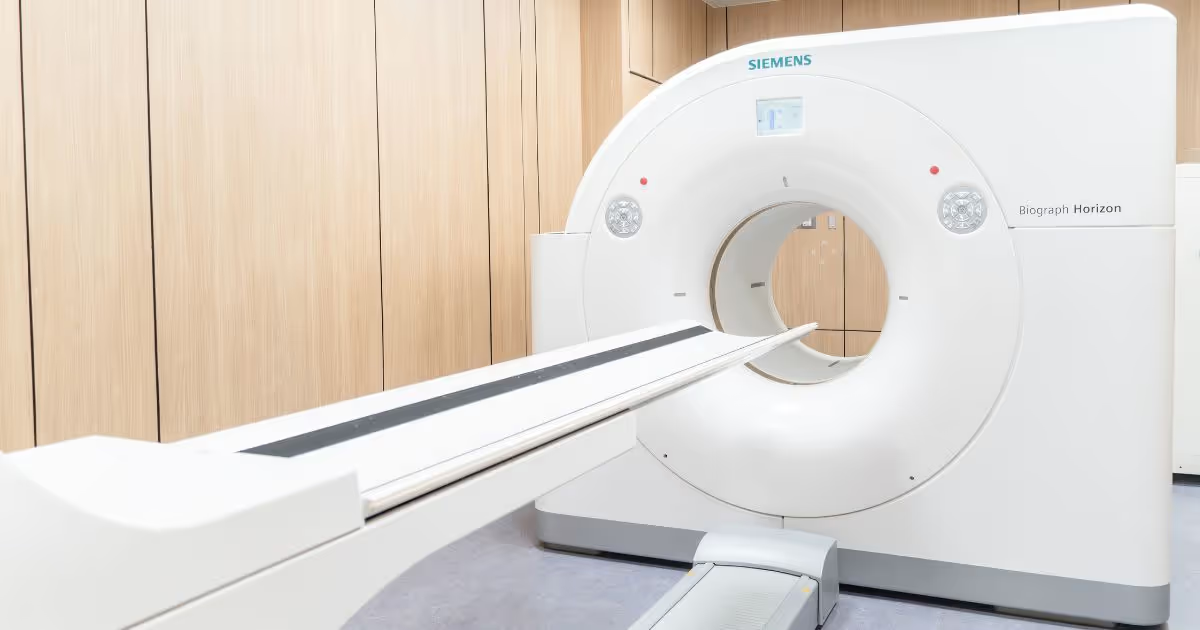Positron Emission Tomography and Computed Tomography (PET/CT) Scan
PET/CT scan is a medical imaging of internal organs and tissues at the molecular level utilizing radiopharmaceuticals.
Positron Emission Tomography (PET) creates images based on positron-emitting radioisotopes accumulated in the abnormal areas within the human body. However, the molecular images captured cannot pinpoint the location of their sources within the body; fusion with Computed Tomography (CT) images yields precise anatomic location of the lesions.
PET/CT scan can detect many abnormal lesions, most often for malignancy, including breast, prostate, and lung cancers. It can also help diagnose fever of unknown origin, Parkinson's disease, and epilepsy.
Before a PET/CT scan2
- Assessment of the patient at least one day before the procedure to measure blood sugar level, ability to remain supine for at least 20-30 minutes, and claustrophobia.
- Inform your doctor if you are or suspect that you are pregnant, breastfeeding, or if you are allergic to foods or drugs.
On the test day - Do not wear any jewelry, particularly metallic ones.
- In certain instances, you may be asked not to drink or eat at least 6 hours before the procedure, depending on the type of scan.
- Bring along the medication you have been taking.
- Do not take along children or pregnant women.
How does a PET/CT scan work?
PET/CT scan requires injection of specific radiopharmaceuticals for a particular disease, such as 18F-FDG (18F-fluorodeoxyglucose) for most cancers and infections; 68Ga-PSMA (68Gallium-Prostate Specific Membrane Antigen) or 18F-PSMA (18Fluorine-Prostate Specific Membrane Antigen), widely used for prostate cancer.
After the injection, the patient rests for 30-60 minutes, allowing the body to absorb the radiopharmaceuticals. The scanning process usually takes about 20-40 minutes. Certain patients may also require contrast media injection based on doctors' discretion.
PET/CT Images
After the procedure2
- Drink plenty of water for frequent urination to flush out the residual radioactive substances.
- Avoid staying close to children and pregnant women for at least 10 hours after the radiopharmaceutical injection, depending on the type and quantity of radiopharmaceuticals.
- Refrain from breastfeeding for 24 hours.
Is it safe to have a PET/CT scan?4
The radiopharmaceuticals used are not harmful because the dose is very low, and complete elimination through urination and natural decay occurs within 24 hours, depending on the type of radiopharmaceuticals.
Which PET/CT scan is the most common?
PET/CT scan with 18F-FDG is the most common procedure because it can detect almost all types of cancer, such as cervical cancer, lung cancer, lymphoma, etc. It can also diagnose infections, fever of unknown origin5, dementia, or Alzheimer's disease.
When should you have an 18F-FDG PET/CT scan? 1,2
Improper or ill-timed 18F-FDG PET/CT scans can result in erroneous results. The proper timing for the test should be:
- A week after the biopsy.
- Six weeks after surgery (depending on the type of surgery).
- 4-6 weeks after chemotherapy.
- 4-6 months after radiotherapy.
- Five days after taking bone marrow hematopoietic agents.
How to prepare yourself before an 18F-FDG PET/CT scan2
- Keep blood sugar below 180 mg/dL.
- Refrain from eating anything except water 6 hours before the procedure.
- Avoid exercising, vigorous activities, or having a massage 1-2 days before the scan.
18F-FDG PET/CT scan2
You will receive 18F-FDG through the IV route, then rest for one hour to allow complete absorption of the radiopharmaceutical. The scan itself takes another 20-30 minutes.
A PET/CT scan can detect cancerous cells throughout the body, from head to toe. It has high sensitivity and accuracy in detecting cancer, including assessing treatment responses and prognosis.
References:
- https://www.chulacancer.net/uploads/pdf/PET-CT.pdf
- IAEA. Standard operating procedures for PET–CT: a practical approach for use in adult oncology: IAEA; 2013.
- Fendler, Wolfgang P., et al. "PSMA PET/CT: joint EANM procedure guideline/SNMMI procedure standard for prostate cancer imaging 2.0." European journal of nuclear medicine and molecular imaging 50.5 (2023): 1466-1486.
- Aldousari, H., Abuhadi, N., Izz, M. et al. Assessment of external radiation dose rate after 18FDG-PET/CT examination. Egypt J Radiol Nucl Med 54, 80 (2023).
- Schönau V, Vogel K, Englbrecht M, et alThe value of 18F-FDG-PET/CT in identifying the cause of fever of unknown origin (FUO) and inflammation of unknown origin (IUO): data from a prospective studyAnnals of the Rheumatic Diseases 2018;77:70-77.

